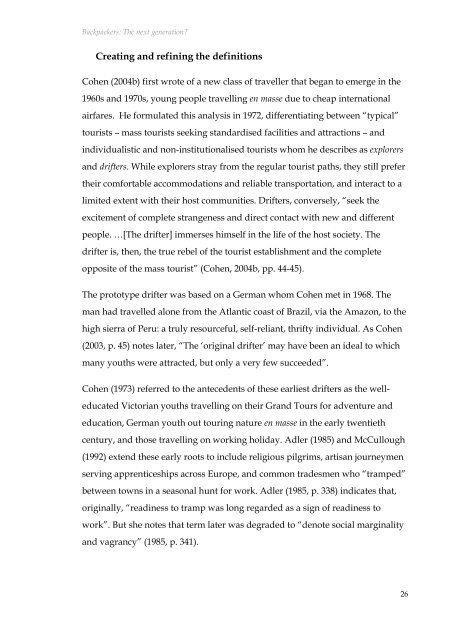Backpackers: The next generation? - Scholarly Commons Home
Backpackers: The next generation? - Scholarly Commons Home
Backpackers: The next generation? - Scholarly Commons Home
You also want an ePaper? Increase the reach of your titles
YUMPU automatically turns print PDFs into web optimized ePapers that Google loves.
<strong>Backpackers</strong>: <strong>The</strong> <strong>next</strong> <strong>generation</strong>?<br />
Creating and refining the definitions<br />
Cohen (2004b) first wrote of a new class of traveller that began to emerge in the<br />
1960s and 1970s, young people travelling en masse due to cheap international<br />
airfares. He formulated this analysis in 1972, differentiating between “typical”<br />
tourists – mass tourists seeking standardised facilities and attractions – and<br />
individualistic and non-institutionalised tourists whom he describes as explorers<br />
and drifters. While explorers stray from the regular tourist paths, they still prefer<br />
their comfortable accommodations and reliable transportation, and interact to a<br />
limited extent with their host communities. Drifters, conversely, “seek the<br />
excitement of complete strangeness and direct contact with new and different<br />
people. …[<strong>The</strong> drifter] immerses himself in the life of the host society. <strong>The</strong><br />
drifter is, then, the true rebel of the tourist establishment and the complete<br />
opposite of the mass tourist” (Cohen, 2004b, pp. 44-45).<br />
<strong>The</strong> prototype drifter was based on a German whom Cohen met in 1968. <strong>The</strong><br />
man had travelled alone from the Atlantic coast of Brazil, via the Amazon, to the<br />
high sierra of Peru: a truly resourceful, self-reliant, thrifty individual. As Cohen<br />
(2003, p. 45) notes later, “<strong>The</strong> ‘original drifter’ may have been an ideal to which<br />
many youths were attracted, but only a very few succeeded”.<br />
Cohen (1973) referred to the antecedents of these earliest drifters as the well-<br />
educated Victorian youths travelling on their Grand Tours for adventure and<br />
education, German youth out touring nature en masse in the early twentieth<br />
century, and those travelling on working holiday. Adler (1985) and McCullough<br />
(1992) extend these early roots to include religious pilgrims, artisan journeymen<br />
serving apprenticeships across Europe, and common tradesmen who “tramped”<br />
between towns in a seasonal hunt for work. Adler (1985, p. 338) indicates that,<br />
originally, “readiness to tramp was long regarded as a sign of readiness to<br />
work”. But she notes that term later was degraded to “denote social marginality<br />
and vagrancy” (1985, p. 341).<br />
26

















